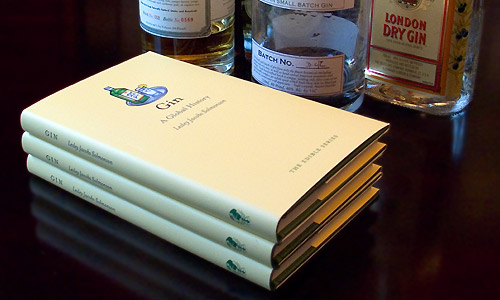by Nora Boydston
Gin: A Global History by Leslie Jacobs Solmonson and Vodka: A Global History by Patricia Herlihy are two delicious, well-mixed cocktails of history and booze. The first thing I learned from these books is alcohol’s long-lasting dual effect on society. It seems that from the moment we discovered how to make it, alcohol has been a substance that we use to celebrate life, and one that we abuse, bringing illness and death. People drink when they’re happy and people drink when they’re unhappy.
I also learned that every kind of liquor has its own story. In these handsomely bound little volumes, part of the Edible series from Reaktion Books, the authors retell the centuries-long and always fascinating stories of vodka and gin.
In many respects these two potent potables are very similar: they are both clear, neutral grain spirits. Both were originally used medicinally and both have been consumed with shocking excess at different times throughout history. But they are also quite unique in more ways than just flavor profile. Jacobs Solmonson writes that gin’s origins can be traced back to early Arab alchemists while vodka’s origins, Patricia Herlihy notes, remains quite bitterly disputed by two countries who claim ownership—Russia and Poland.
Although they have their roots abroad, both vodka and gin had revolutionary effects in the United States and are perhaps almost as entwined with American national history as they are with their countries of origin. This is partly due to American immigrants who, upon arriving in the United States, felt homesick and craving a taste of familiarity, introduced the national liquors of their fatherlands to The U.S.
The history of gin and vodka in the United States could also be summed up with one word: martini. Cocktails were invented in America and the martini is arguably the premier cocktail, originally made with gin. But as tastes and times changed, vodka became synonymous with the martini, and was eventually the clear liquor of choice in the United States.
In my opinion, there was but one hindrance in both books: the tone remained a little flat. Despite the addition of many full color photos throughout, including gorgeous vintage advertisements as well as strange and funny temperance posters, the books felt too scholarly, never quite rising above the tenor of a thorough encyclopedia entry to what I would call a passion project.
If you’re looking for affectionately or exuberantly told anecdotes, a love letter to a favorite liquor, you won’t necessarily find it here. What you will find however is a comprehensive global history of these famous liquors and a trove of information about current innovations including the exciting new artisanal brands and the many creative marketing strategies employed by liquor companies, all of which are of interest to the novice, but perhaps already known by the connoisseur.
As a partaker of both gin and vodka, but not knowing anything about how they are made, I thoroughly enjoyed the information on the process of distilling alcohol. These books provide ideal conversation fodder for slightly nerdy foodies who also happen to love history. And there are moments of true brilliance contained within, like when Patricia Herlihy declares that vodka is a postmodern drink. Although these books do seem to share the quiddity of vodka—neutrality, simplicity and versatility—they are far from what I would call postmodern food writing. A dash of innovation and creativity could have elevated these books from merely interesting to something truly exciting.
Nora Boydston is the founder of CartwheelsForJustice.org and received her MFA in Fiction from The New School.


1 Comment
Cool review! As an avid gin consumer and and aficionado of the gins available on the American market, I would certainly consider purchasing this book. It’s apparent that “a dash of innovation and creativity” were well mixed in the writing of this review. Congrats Nora!
-Bud Van Genderen